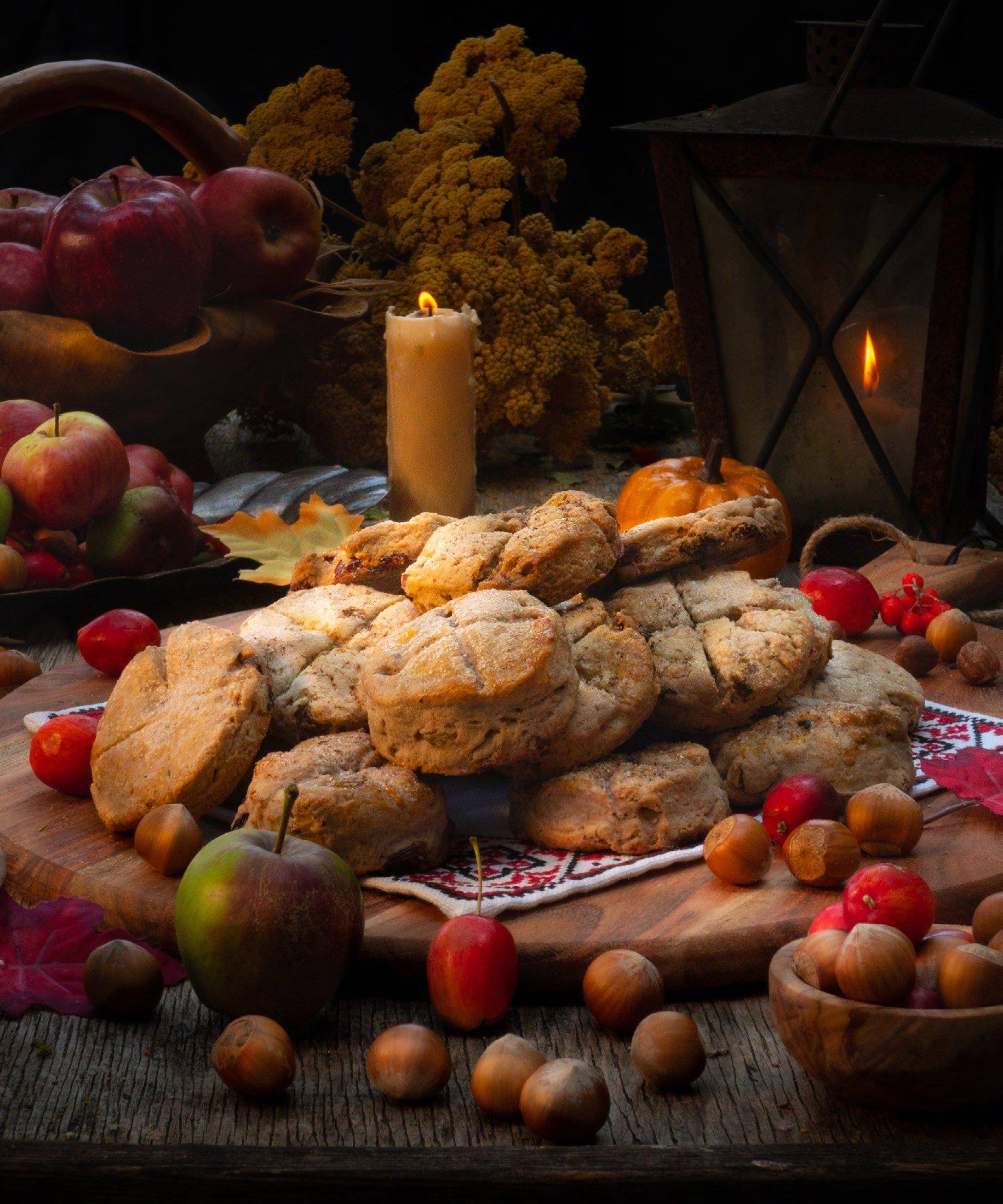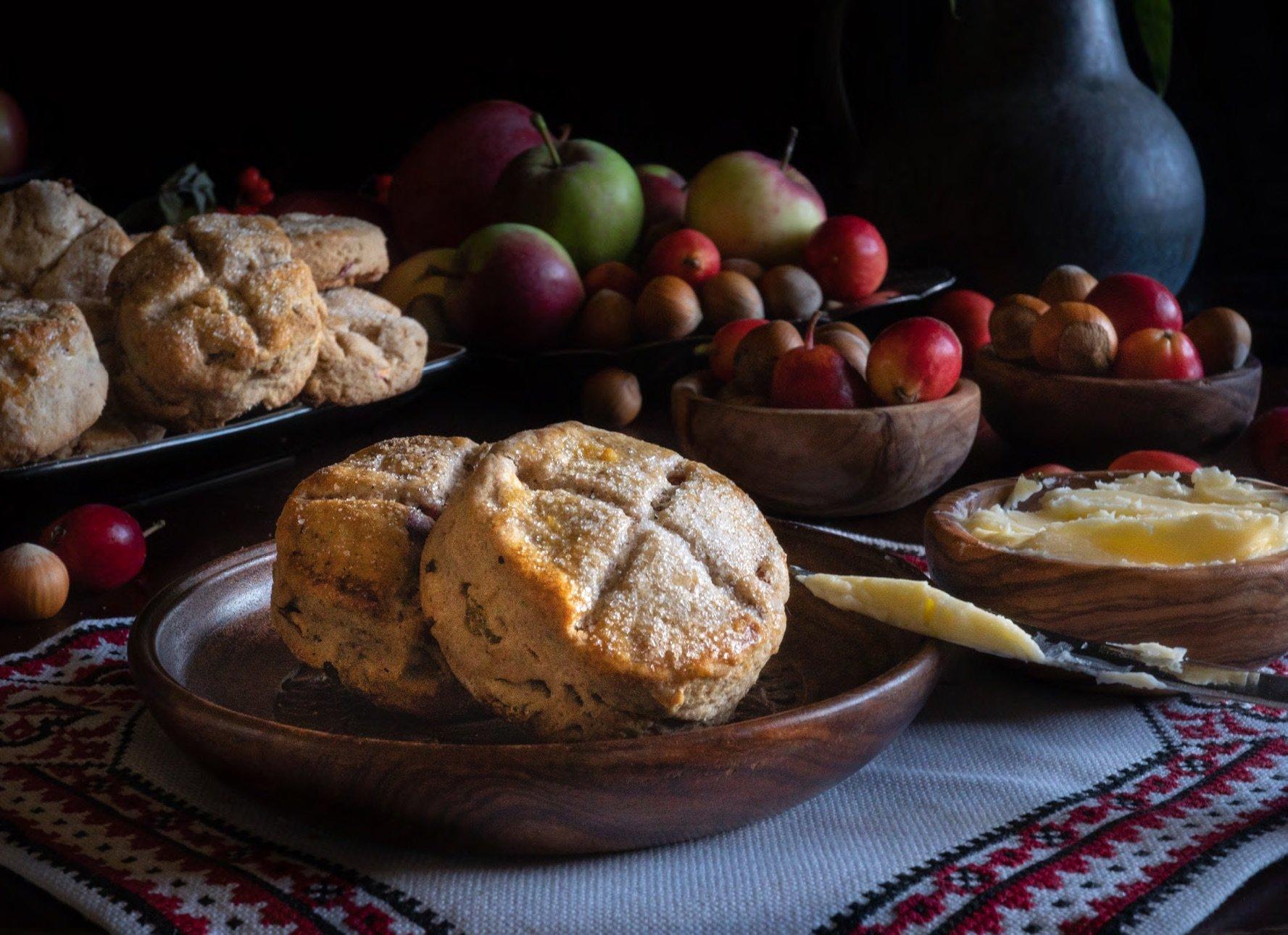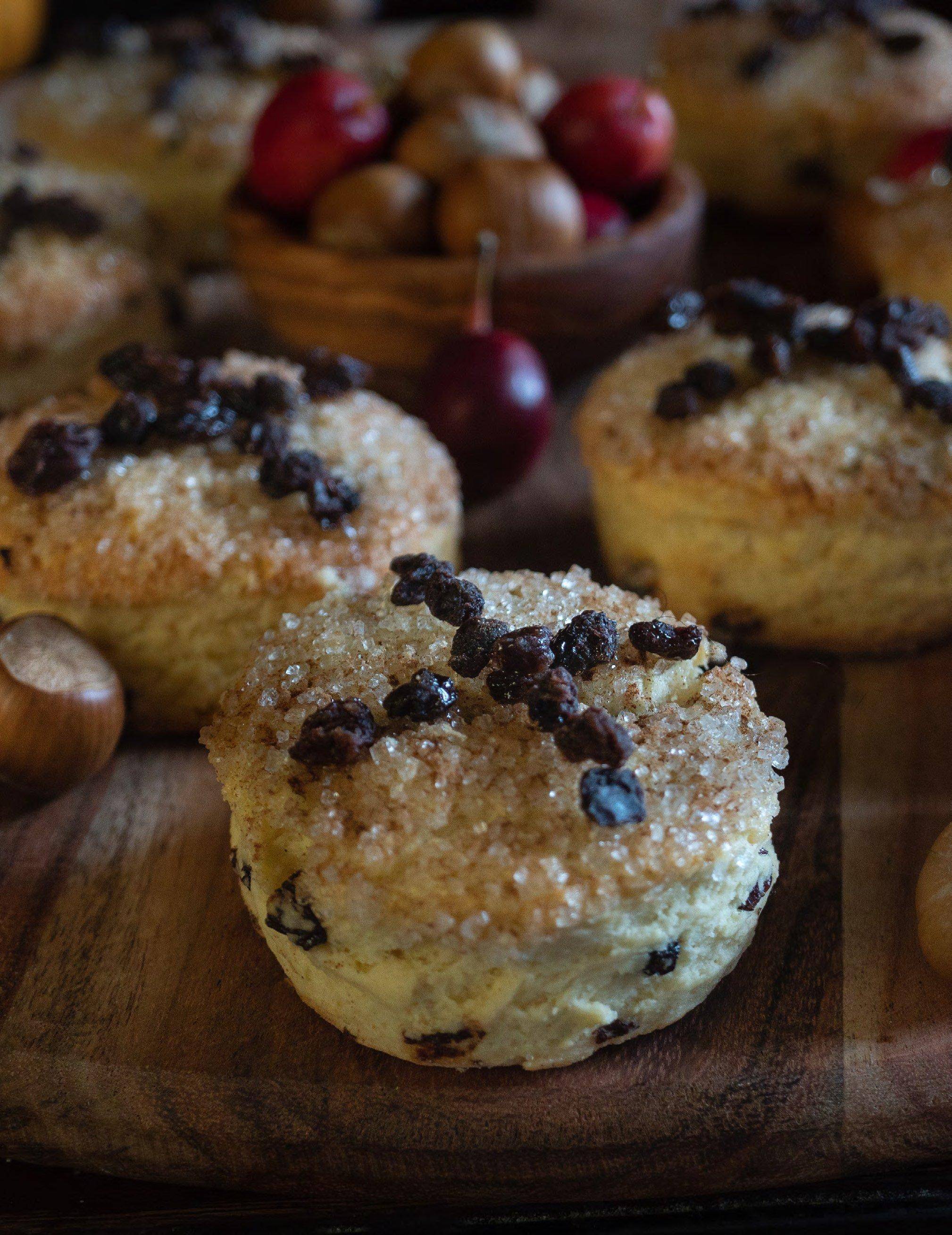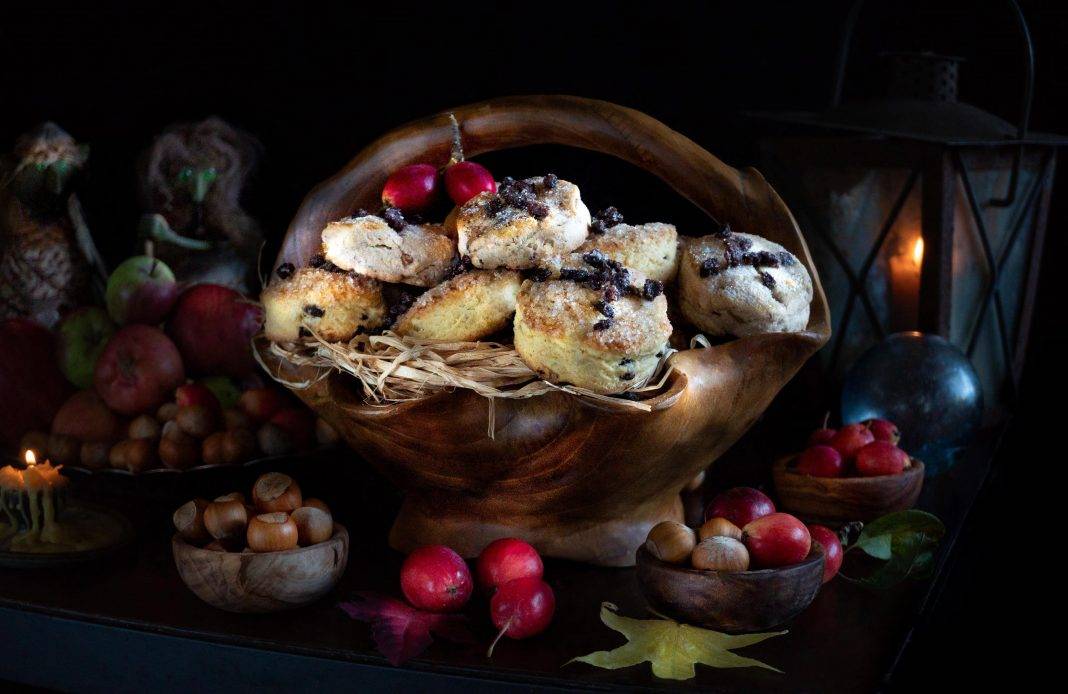RECIPE AND PHOTOGRAPHY BY DANIELLE PROHOM OLSON (A.K.A. GATHER VICTORIA)
Looking for a little inspiration for some “all hallowed” food magic? While we may think of all things pumpkin when it comes to Halloween, according to old world food folklore, sweet little cakes, tart crabapples, and roasted hazelnuts were the original treats for both the living and the dead. Whether we’re talking Hallowtide or Samhain, these foods were credited with all kinds of powers from scrying into the future to granting eternal life, saving souls, and warding off evil spirits.
Hence this recipe for crabapple and hazelnut All Hallows’ cakes. By modern baking standards they are more like scones than cakes, but they’re filled with autumn food traditions dating back thousands of years. Their story begins with the old Celtic celebration of Samhain, or summer’s end. Marking the night that the light half of the year shifted into the dark, this magical time of betwixt and between was when the veil between worlds thinned—and the hungry dead came a-callin’! An important time for procuring the favors of the ancestors with food—especially cake.
A special place for the ancestors was set at the table, and small unleavened “cakes,” often sweetened with honey and filled with sacred fruits and nuts, were served. Doors and windows would be opened to invite the dearly departed in. Cakes were also left outside doorsteps, in villages and farm fields as offerings to the ancestral spirits of the land and fairies. Today in some parts of the U.K., All Hallows’ Eve is still known as “caking night.”
References to “caking night” or “kakin night” are believed to stem from the Christian practice of “souling.” Small round cakes (often simply called souls) were marked with a cross and given out to soulers (mainly children) who went door to door. For each soul cake received, a prayer was said to release the souls of the recently dead from purgatory.
The custom of souling began sometime in the middle ages after Pope Gregory III absorbed the old pagan practices of ancestor veneration into the Christian holiday of Hallowmas. It began the evening of October 31, All Hallows’ Eve (All Saints’ Eve), and lasted until All Souls’ Day on November 2, which commemorated the faithful departed. Soul cakes are still part of Catholic cuisine, with many recipes developed over time and regions. Described as a cross between a cookie, biscuit, and scone, the soul cake often contains raisins, currants, and spices like nutmeg, cinnamon, and ginger.

Whether soul cakes descend from earlier Celtic cakes no one can say for sure, but small round cakes symbolizing the sun and the eternal cycle of life have long been part of pagan food traditions. Some scholars suggest the scored cross was originally a magical symbol for the wheel of the year. As food historian Tamra Andrew writes in Nectar and Ambrosia: An Encyclopedia of Food in World Mythology, “Cakes, in the ancient world, had ties with the annual cycle, and people used them as offerings to the gods and spirits who exercised their powers at particular times of the year … Agricultural peoples around the globe made offerings of cakes prepared from the grains and fruits that arose from the soil. The types of ingredients used to make these cakes contributed to their symbolism.”
Samhain was the time of a ceremonial final harvest before winter set in. Which is why crabapple and hazelnut were the natural choices for my All Hallows’ cakes—both were key in the natural magic of the season. In many parts of Ireland and England, Halloween is still referred to as “snap apple night” and “nutcracker night.” Long before the common apple was introduced by the Romans, the only apple in the British Isles was the wild crabapple. In Celtic tradition, crabapples were symbols of rebirth and buried at Samhain as food for those souls waiting to be reborn. Crabapples were also associated with that other big Samhain activity—divination. According to some legends, a fermented alcoholic crabapple cider known as Witches’ Brew gave Merlin his powers of prophecy. Young women would toss the peels over their shoulders at midnight, and as the peels fell, they would spell out the initials of the women’s future husbands.
Hazelnuts too were reputed to have divinatory powers. In Celtic myth, the hazel tree stands at the center of the otherworld and overhangs the Well of Enchantment. Traditionally, witches are said to eat a hazelnut on Halloween prior to scrying crystal balls or using other divining methods to see into the future. Women in 19th century Scotland would designate a hazelnut for each of their love interests, then toss the nuts into a fire on Halloween. The nut that popped indicated the identity of their betrothed to be. Similarly, if a woman ate a dessert of sugary hazelnuts and nutmeg before going to sleep
on Halloween, she’d dream of the face of her future husband.
While I am already in possession of a husband, it would be handy to scry into the future on this night when the veil between the worlds is thinnest. So I decided that baking up some crabapple and hazelnut All Hallows’ cakes would be a wonderful way to honor the ancestors and observe time-honored food traditions.
And to entreat a few extra favors from my beloved on the other side, I sugared and brushed them with a cream-and-egg-yolk caudle “of the most luxurious kind,” according to Isobel Grant, author of Highland Folk-Ways. And to avert any bad omens or bad luck, I served them with plenty of butter “without the asking.”

CRABAPPLE AND HAZELNUT ALL HALLOWS’ CAKES
Makes 12 to 15 2-inch soul cakes
Ingredients
2½ cups all-purpose flour
3 tablespoons finely chopped crabapples (or tart apple) 2 tablespoons chopped roasted hazelnuts
3 tablespoons golden currants or raisins
¼ cup dark currants or raisins
1 teaspoon nutmeg
1 teaspoon cinnamon
2 teaspoons of minced ginger (fresh or candied)
½ teaspoon salt
4 teaspoons baking powder
½ cup sugar
2 egg yolks
½ cup milk (you may need more or less)
1 stick (8 tablespoons) unsalted butter, cut into cubes
For the Caudle Glaze:
1 egg yolk, beaten
1 teaspoon cream
¼ cup granulated sugar
Preheat the oven to 400ºF. Line two baking pans with parchment paper.
In a large bowl, combine the flour, sugar, salt, baking powder, nutmeg, cinnamon, and ginger. Mix well with a fork.
Add the cubed butter and cut with a pastry cutter or a fork until the butter is the size of large peas.
Add the egg yolks one at a time, blending with the back of a spoon.
Add golden currants, crabapples, hazelnuts, and dark currants (save a handful for decorating the tops of your cakes). Then, one tablespoon at a time, begin adding in the milk, blending until a soft dough begins to form. You may not need all of your milk.
Turn the dough out onto a floured counter and knead gently a few times. Without over-kneading, roll out gently to a thickness of 1 inch. Using a 2-inch round cookie- or biscuit cutter, cut out your rounds and set on your baking sheets.
Beat together your egg yolk and cream, and brush this mixture over the tops of the cakes. Sprinkle generously with sugar and decorate with the remaining black currants. Bake for 15 to 20 minutes, until golden and shiny.
Follow Danielle Prohom Olson (a.k.a. Gather Victoria) on her blog at gathervictoria.com.



































